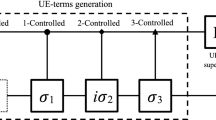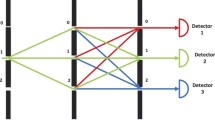Abstract
The Yang-Baxter equation has become a significant theoretical tool in a variety of areas of physics. It is desirable to investigate the quantum simulation of the Yang-Baxter equation itself, exploring the connections between quantum integrability and quantum information processing, in which the unity of both the Yang-Baxter equation system and its quantum entanglement should be kept as a whole. In this work, we propose a duality quantum simulation algorithm of the Yang-Baxter equation, which contains the Yang-Baxter system and an ancillary qubit. Contrasting to conventional methods in which the two hand sides of the equation are simulated separately, they are simulated simultaneously in this proposal. Consequently, it opens up a way to further investigate entanglements in a Yang-Baxter equation.



Similar content being viewed by others
References
Yang, C.N.: Some exact results for the many-body problem in one dimension with repulsive delta-function interaction. Phys. Rev. Lett. 19, 1312–1315 (1967)
Yang, C.N.: S matrix for the one-dimensional N-body problem with repulsive or attractive delta-function interaction. Phys. Rev. 168, 1920–1923 (1968)
Baxter, R.J.: Exactly Solved Models in Statistical Mechanics. Academic, New York (1982)
Baxter, R.J.: Partition function of the Eight-Vertex lattice model. Ann. Phys. 70, 193–228 (1972)
Jimbo, M. (ed.): Yang-Baxter Equation in Integrable Systems. World Scientific, Singapore (1990)
Frenkel, I.B., Jing, N.: Vertex representations of quantum affine algebras. Proc. Natl. Acad. Sci. USA 85, 9373–9377 (1988)
Gerstenhaber, M., Schack, S.D.: Bialgebra cohomology, deformations, and quantum groups. Proc. Natl. Acad. Sci. USA 87, 478–481 (1990)
Yang, C.N., Ge, M.L.: Braid Group, Knot Theory and Statistical Mechanics, 2nd edn., pp. 1–176. World Scientific, Singapore (1994)
Billey, S.C.: Kostant polynomials and the cohomology ring for G/B. Proc. Natl. Acad. Sci. USA 94, 29–32 (1997)
Sun, C.P.: The differential realization of new solutions for Yang–Baxter equation. Chin. Sci. Bull. 37, 379 (1992)
Gui, P.: Another solution of Yang–Baxter equation on set and ‘metahomomorphisms on groups’. Chin. Sci. Bull. 42, 1852–1855 (1997)
Chen, H.X.: Cpcycle deformations, braided monoidal categories and quasitriangularity. Chin. Sci. Bull. 44, 510–513 (1999)
Hou, D.P., Bai, C.M.: J-dendriform algebras. Front. Math. Chin. 7, 29–49 (2012)
Dubail, J., Jacobsen, J.L., Saleur, H.: Exact solution of the anisotropic special transition in the O(n) model in two dimensions. Phys. Rev. Lett. 103, 145701 (2009)
Mattis, D.C.: The Many-Body Problem, pp. 419–472. World Scientific, Singapore (1993)
Nielsen, M.A., Chuang, I.L.: Quantum Computation and Quantum Information, pp. 1–607. Cambridge University Press, Cambridge (2000)
Li, S.S., Long, G.L., Bai, F.S., Feng, S.L., Zheng, H.Z.: Quantum computing. Proc. Natl. Acad. Sci. USA 98, 11847–11848 (2001)
Dye, H.A.: Unitary solutions to the Yang–Baxter equation in dimension four. Quant. Info. Proc. 2, 117–152 (2003)
Kauffman, L.H., Lomonaco, S.J. Jr.: Braiding operators are universal quantum gates. New J. Phys. 6, 134 (2004)
Zhang, Y., Kauffman, L.H., Ge, M.L.: Universal quantum gate, Yang–Baxterization and Hamiltonian. Int. J. Quantum. Inform. 3, 669–678 (2005)
Franko, J.M., Rowell, E.C., Wang, Z.: Extraspecial 2-groups and images of braid group representations. J. Knot Theory Ramif. 15, 413–427 (2006)
Rowell, E.C., Zhang, Y., Wu, Y.S., Ge, M.L.: Extraspecial two-groups, generalized Yang–Baxter equations and braiding quantum gates. Quantum Inf. Comput. 10, 685–702 (2010)
Zhang, Y., Ge, M.L.: GHZ States, almost-complex structure and Yang–Baxter equation. Quantum Inf. Process. 6, 363–379 (2007)
Chen, J.L., Xue, K., Ge, M.L.: Braiding transformation, entanglement swapping, and Berry phase in entanglement space. Phys. Rev. A 76, 042324 (2007)
Kitaev, A.Y.: Fault-tolerant quantum computation by anyons. Ann. Phys. 303, 2–30 (2003)
Freedman, M.H., Kitaev, A.Y., Wang, Z.H.: Simulation of topological field theories by quantum computers. Commun. Math. Phys. 227, 587–603 (2002)
Ardonne, E., Schoutens, K.: Wavefunctions for topological quantum registers. Ann. Phys. 322, 201–235 (2007)
Feiguin, A., Trebst, S., Ludwig, A.W.W., Troyer, M., Kitaev, A., Wang, Z., Freedman, M.H.: Interacting anyons in topological quantum liquids: the golden chain. Phys. Rev. Lett. 98, 160409 (2007)
Nayak, C., Simon, S.H., Stern, A., Freedman, M., Sarma, S.D.: Non-Abelian anyons and topological quantum computation. Rev. Mod. Phys. 80, 1083–1159 (2008)
Hikami, K.: Skein theory and topological quantum registers: braiding matrices and topological entanglement entropy of non-Abelian quantum Hall states. Ann. Phys. 323, 1729–1769 (2008)
Bose, S., Korepin, V.: Quantum gates between flying qubits via spin-independent scattering (2011). arXiv:1106.2329v1
Yao, X.C., Wang, T.X., Chen, H.Z., Gao, W.B., Fowler, A.G., Raussendorf, R., Chen, Z.B., Liu, N.L., Lu, C.Y., Deng, Y.J., Chen, Y.A., Pan, J.W.: Experimental demonstration of topological error correction. Nature 482, 489–494 (2012)
Hu, S.W., Xue, K., Ge, M.L.: Optical simulation of the Yang-Baxter equation. Phys. Rev. A 78, 022319 (2008)
Zheng, C., Li, J.L., Song, S.Y., Long, G.L.: Direct experimental simulation of the Yang–Baxter equation. J. Opt. Soc. Am. B 30(6), 1688–1693 (2013)
Anvari Vind, F., Foerster, A., Oliveira, I.S., et al.: Experimental realization of the Yang–Baxter equation via NMR interferometry. Sci. Rep. 6, 20789 (2016)
Batchelor, M.T., Foerster, A.: Yang–Baxter integrable models in experiments: from condensed matter to ultracold atoms. J. Phys. A: Math. Theor. 49, 173001 (2016)
Feynman, R.: Simulating physics with computers. Int. J. Theor. Phys. 21, 467–488 (1982)
Greiner, M., Mandel, O., Bloch, I., et al.: Quantum phase transition from a superuid to a Mott insulator in a gas of ultracold atoms. Nature 415, 39–44 (2002)
Leibfried, D., DeMarco, B., Wineland, D.J., et al.: Trapped-ion quantum simulator: experimental application to nonlinear interferometers. Phys. Rev. Lett. 89, 247901 (2002)
Friedenauer, A., Schmitz, H., Schatz, T., et al.: Simulating a quantum magnet with trapped ions. Nat. Phys. 4, 757–761 (2008)
Kim, K., Duan, L.M., Monroe, C., et al.: Quantum simulation of frustrated Ising spins with trapped ions. Nature 465, 590–593 (2010)
Lanyon, B.P., Aspuru-Guzik, A., White, A.G.: Towards quantum chemistry on a quantum computer. Nat. Chem. 2, 106–111 (2010)
Gerritsma, R., Blatt, R., Roos, C., et al.: Quantum simulation of the Dirac equation. Nature 463, 68–71 (2010)
Aspuru-Guzik, A., Walther, P.: Photonic quantum simulators. Nat. Phys. 8, 285–291 (2012)
Feng, G.R., Lu, Y., Long, G.L., et al.: Experimental simulation of quantum tunneling in small systems. Sci. Rep. 3, 2232 (2013)
Neill, C., Roushan, P., Martinis, J.M., et al.: Ergodic dynamics and thermalization in an isolated quantum system. Nat. Phys. (2016). https://doi.org/10.1038/nphys383
Li, H., Gao, X., Xin, T., et al.: Experimental study of Forrelation in nuclear spins. Sci. Bull. 62(7), 497–502 (2017)
Pearson, J., Feng, G.R., et al.: Experimental quantum simulation of Avian Compass in a nuclear magnetic resonance system. Sci. China Phys. Mech. Astron. 59 (12), 120312 (2016)
Jin, F.Z., Chen, H.W., Rong, X., et al.: Experimental simulation of the Unruh effect on an NMR quantum simulator. Sci. China Phys. Mech. Astron. 59(3), 630302 (2016)
Li, H., Liu, Y., Long, G.L.: Experimental realization of single-shot nonadiabatic holonomic gates in nuclear spins. Sci. China Phys. Mech. Astron. 60(8), 080311 (2017)
Kong, X.Q., Li, Q., Wu, C.H., et al.: Multiple-server flexible blind quantum computation in networks. Int. J. Theor. Phys. 55, 3001 (2016)
Cai, J.M.: Quantum simulation meets quantum biology. Sci. China Phys. Mech. Astron. 60, 030331 (2017)
Sheng, Y.B., Zhou, L.: Distributed secure quantum machine learning. Sci. Bull. 62, 1025 (2017)
Nagata, K., Nakamura, T., Farouk, A.: Quantum cryptography based on the Deutsch-Jozsa algorithm. Int. J. Theor. Phys. 56, 2086 (2017)
Diep, D.N., Giang, D.H., Minh, N.V.: Quantum Gauss-Jordan elimination and simulation of accounting principles on quantum computers. Int. J. Theor. Phys. 56, 1948 (2017)
Zheng, C., Hao, L., Long, G.L.: Observation of a fast evolution in a parity-time-symmetric system. Phil. Trans. R. Soc. A 371, 20120053 (2013)
Tang, J.C., Li, C.F., Guo, G.C., et al.: Experimental investigation of the no-signalling principle in parity–time symmetric theory using an open quantum system. Nat. Photonics.https://doi.org/10.1038/nphoton.2016.144 https://doi.org/10.1038/nphoton.2016.144 (2016)
Long, G.L.: General quantum interference principle and duality computer. Commun. Theor. Phys. 45(5), 825–844 (2006)
Temperley, H.N.V., Lieb, E.H.: Relations between the “percolation” and “colouring” problem and other graph-theoretical problems associated with regular planar lattices: some exact results for the “percolation” problem. Proc. R. Soc. London Ser. A 322, 251–280 (1971)
Long, G.L., Liu, Y.: Duality computing in quantum computers. Commun. Theor. Phys. 50(6), 1303–1306 (2008)
Long, G.L., Liu, Y., Wang, C.: Allowable generalized quantum gates. Commun. Theor. Phys. 51(1), 65–67 (2009)
Long, G.L.: Duality quantum computing and duality quantum information processing. Int. J. Theor. Phys. 50, 1305–1318 (2011)
Gudder, S.: Mathematical theory of duality quantum computers. Quantum Inf. Process. 6(1), 37–48 (2007)
Long, G.L.: Mathematical theory of the duality computer in the density matrix formalism. Quantum Inf. Process. 6(1), 49–54 (2007)
Gudder, S.: Duality quantum computers and quantum operations. Int. J. Theor. Phys. 47(1), 268–279 (2008)
Wang, Y.Q., Du, H.-K., Dou, Y.N.: Note on generalized quantum gates and quantum operations. Int. J. Theor. Phys. 47(9), 2268–2278 (2008)
Long, G.L., Liu, Y.: Duality quantum computing. Front. Comput. Sci. 2(2), 167–178 (2008)
Long, G.L., Liu, Y.: General principle of quantum interference and the duality quantum computer. Rep. Prog. Phys. 28, 410–431 (2008)
Cui, J.X., Zhou, T., Long, G.L.: Density matrix formalism of duality quantum computer and the solution of zero-wave-function paradox. Quantum Inf. Process. 11 (2), 317–323 (2012)
Cao, H.X. et al.: Mathematical theory of generalized duality quantum computers acting on vector-states. Int. J. Theor. Phys. 52(6), 1751–1767 (2013)
Cao, H.X. et al.: Mathematical theory of generalized duality quantum computers acting on vector-states. Int. J. Theor. Phys. 52(6), 1751–1767 (2013)
Zou, X.F., Qiu, D.W., Wu, L.H., Li, L.J., Li, L.Z.: On mathematical theory of the duality computers. Quantum Inf. Process. 8(1), 37–50 (2009)
Wei, S.J., Zou, Z.R., Ruan, D., Long, G.L.: Realization of the algorithm for system of linear equations in duality quantum computing. In: Proceeding 2017 IEEE 85th Vehicular Technology Conference (VTC2017-Spring) (2017)
Wei, S.J., Long, G.L.: Duality quantum computer and the efficient quantum simulations. Quantum Inf. Process. 15(3), 1189–1212 (2016)
Wei, S.J., Ruan, D., Long, G.L.: Duality quantum algorithm efficiently simulates open quantum systems. Sci. Rep. 6, 30727 (2016)
Long, G.L. et al.: Realistic interpretation of quantum mechanics and encounter-delayed-choice experiment. Sci. China Phys. Mech. Astron. 61(3), 030311 (2018)
Qiang, X., Zhou, X., Aungskunsiri, K., et al.: Quantum processing by remote quantum control[J]. Quantum Sci. Technol. 2(4), 045002 (2017)
Marshman, R.J., Lund, A.P., Rohde, P.P., Ralph, T.C.: Passive quantum error correction of linear optics networks through error averaging (2017). arXiv:http://arxiv.org/abs/1709.02157
Neeley, M., Ansmann, M., Martinis, J.M., et al.: Emulation of a quantum spin with a superconducting phase qudit. Science 325, 722–725 (2009)
Nielsen, M.A., Chuang, I.L.: Quantum Computation and Quantum Information, pp. 221–225. Cambridge University Press, Cambridge (2000)
Cao, Y., Peng, S.G., Zheng, C., Long, G.L.: Quantum fourier transform and phase estimation in qudit system. Commun. Theor. Phys. 55, 790–794 (2011)
Acknowledgements
This work was supported by the National Natural Science Foundation of China Grant No. 11705004, Open Research Fund Program of the State Key Laboratory of Low-Dimensional Quantum Physics No. KF201710, Organization Department of Beijing Municipal Committee Talents Project No. 2017000020124G050, NCUT ‘The Belt and Road Initiatives’ and Research Startup Fund, and the Fundamental Research Funds of Beijing Municipal Education Commission.
Author information
Authors and Affiliations
Corresponding author
Rights and permissions
About this article
Cite this article
Zheng, C., Wei, S. Duality Quantum Simulation of the Yang-Baxter Equation. Int J Theor Phys 57, 2203–2212 (2018). https://doi.org/10.1007/s10773-018-3745-z
Received:
Accepted:
Published:
Issue Date:
DOI: https://doi.org/10.1007/s10773-018-3745-z




